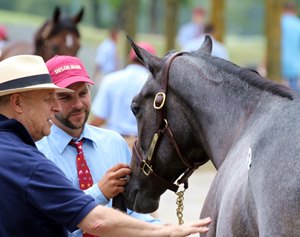Brisk Activity in Advance of Keeneland Sale


By nature, Thoroughbred auctions are rife with uncertainty. A lot depends on which buyers show up, which horses pass—or don’t pass—the pre-sale veterinary inspections, and whether the right people hook up in a bidding war to try to get the top racing prospects.
That said, going into the Keeneland September yearling sale, which begins Sept. 12 and continues daily (with the exception of an off day Thursday, Sept. 15) through Sept. 25, top buyers from around the world have been attracted by an expanded catalog of 4,479 horses with some of the hottest bloodlines in the world.
Pinhookers seeking young horses they can improve upon and sell next year, top trainers in North America and Europe, the biggest spending end users from the U.S., Europe, Japan and South America have all congregated on the sale grounds.
On the morning of Sept. 11, traffic in the barns was brisk as buyers and sellers went about their tasks a day before the first 11 a.m. session Monday.
"There is a good mixture of new faces, familiar faces, and returning faces," said Keeneland sales director Geoffrey Russell as he and other sales company executives milled about the barns on an exceptionally pleasant morning. "It is good to see such a nice cross-section of people."
Despite declines in 2016 yearling sales to date, Russell said he is optimistic that Keeneland will continue an upward trajectory that the September sale has taken in past years as the market recovers from global recession. Since 2009, when 3,159 yearlings averaged 66,850, the sale has steadily improved with 2,745 head changing hands in 2015 for an average price of $113,082.
"We are always optimistic; we are in the horse business," Russell said, adding that the sale has been given a boost by the success of September sale graduates.
Through Labor Day, horses that went through the sales ring in September had won 141 stakes globally, including 38 grade/group I wins, with graded successes not only in North America but Australia, Brazil, Denmark, Dubai, England, France, Ireland, Korea, Kazakhstan, Panama, Russia and Puerto Rico.
"Our graduates have outdone themselves on the racetrack this year," Russell said.
"I've seen enough new people that I am encouraged; we're seeing some new faces," said Wayne Sweezey, who consigns under the Timber Town banner. "The people who are 'well-to-do' are here and they seem interested so I think it's going to hold steady. It's a great place to market a horse, as was the (Fasig-Tipton) Saratoga sale."
Brian Graves, public sales director for Gainesway, said activity by potential buyers for horses consigned in Book 1—the crème de la crème among the sale's offerings based on sire power and strength of female families—has been about the same as in years past.
But that is not unusual, considering there are only a select number of buyers with pocketbooks deep enough to buy the Book 1 bluebloods. "Book 1 and Saratoga are the best that Central Kentucky breeders have to offer. I would expect it to be very good," he said.
Graves said the September sale will likely be a continuation of the trend in which quality is in great demand and with lesser competition for horses in the middle to lower price ranges.
"We feel like the top horses that pass the vet will be very well received and everything else will be hit or miss," Graves said.
Duncan Taylor, of Taylor Made Sales Agency, said there is still an air of uncertainty within the marketplace, possibly driven in part by the presidential election and concerns about the economy going forward.
"The stock market is strong, although it had a little correction Friday (Sept. 9)," Taylor said. "We just don’t know what's going to happen."
Craig Bandoroff of Denali Stud said he has seen some buyers he had not seen at the U.S. sales recently.
"There are some Europeans I have not seen in a long time and that is nice to see," he said, adding that the top lots approved by buyers’ veterinarians will attract the most attention. "It will be the same old story: we'll see which horses make the cut and hope they don't land on the same ones."
